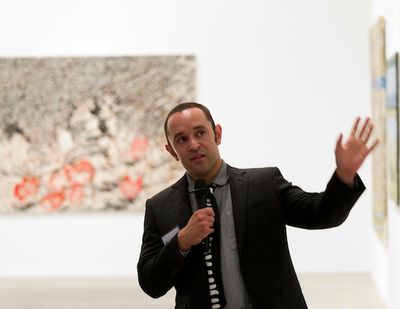Bruce Mclean

Bruce McLean is Curator of Indigenous Australian Art at the Queensland Gallery of Modern Art. His latest exhibition My Country: I Still Call Australia Home
is a collection of recent works by Aboriginal and Torres Strait Islander artists that explore the divergent social and political voices of ‘Black’ Australia. While not all works expressly engage with this political commentary, the oppression of indigenous peoples by the ‘White Australia’ policies of the early 20th century is shown to be a historical legacy that is ever-present in contemporary Australian lives.
What are some of the challenges of bringing together a large-scale exhibition of recent work by indigenous artists in Australia?
The show deals with the idea of country but in different ways. It looks at the idea of relating to a place, but also the idea of the nation and the way that Aboriginal and Torres Strait Islanders are now defining and redefining themselves within the national Australian narrative. As an Aboriginal curator, trying to reflect the diversity of approaches to these issues, including the five hundred varying indigenous groups, is really important. Through the show, you’ll notice that there’s a range of different ideas or opinions on particular subjects and a range of different media. This reflects the varying experiences that people have from different parts of the country: it acknowledges that various histories took place at different times and in different places.
Given the diversity of these artistic approaches the central subject of concern still seems to be the legacy of Australia’s colonial history. Is this something you specifically set out to investigate?
That idea of being political is inherent in a lot of artworks and it reflects the experience of these artists. Many artists growing up through the 60s, 70s and 80s were very much a part of the street-marching protest movements. The idea that Aboriginal people were considered sub-human until 1967—that has a big impact on a lot of artists working today. Many people do make art that has a strong political voice, but they also try to tell these stories in interesting and accessible ways as well. Gordon Hookey’s work has some very political and overt messages, but in developing children’s activities [the Kangaroo Crew] he has also realised that there are other important ways to deliver these messages. The thing about bringing together an exhibition that’s very diverse is that it’s important that people have different points of entry. Not everybody is going to respond to a particular type of work in the same way.
Many recent artists have been concerned with reworking dominant historical narratives—particularly the modernist ‘progressive’ narrative. This has been dubbed the ‘historical turn’ in contemporary art. Could indigenous artists be said to approach this ‘turn’ in a different way?
The histories that people are engaging with are generally very personal. So they’re often engaging with family histories rather than looking at anything broader. People are more interested in telling their own stories because that’s the authority that they have. A lot of contemporary Australian artists that were working through the 70s, 80s, and 90s were looking at similar histories and looking at a historical revisionism of the grand Australian narrative including indigenous ideas. But Aboriginal and Torres Strait Islanders are really looking at those histories that they have before them, rather than those broader ideas because there are protocols that you have to take into account in telling other people’s stories. It’s what they feel they have authority over: even if they’re not traditional stories they still belong to particular families.
Dale Harding’s replica of a ‘King Plate’ is an extraordinary object that says so much about the early history of encounter between indigenous and non-indigenous Australians. [King Plates were a type of breastplate given to an Aboriginal person who was deemed by colonial authorities to be a leader of their group. The plates were metal and were often engraved with a code of letters and numbers used by colonial bodies to identify the wearer.]
Yes, just the idea of making somebody responsible for intercultural connections in this way—by “Kinging” people—is extraordinary. But it also speaks to the idea that you’ve reduced people down to a number. [This subjugation] is reflected in the way that Dale has created his King Plate out of lead and given it weight. Many of these histories remain unresolved and people have tried to hide them away and not talk about them. Those versions of history are rarely, if ever, told about in the mainstream narrative. When people see them in a gallery the overwhelming feedback we get is ‘Why were we never taught about these things?’—‘Why was this history unknown to me?’ because it is part of European Australian history as well as Aboriginal history—it belongs to everyone.
In this respect, how was the show received in Brisbane?
It was fantastic. There’s always a range of responses and some people were really emotionally affected by these issues. A lot of the works about history refer to things that people have never heard about: parts of history that just aren’t taught and learnt versions of Australian history. — [O]








